Pengyu Li
Refer to the report for detailed contributions
PathFinder: Advancing Path Loss Prediction for Single-to-Multi-Transmitter Scenario
Dec 16, 2025Abstract:Radio path loss prediction (RPP) is critical for optimizing 5G networks and enabling IoT, smart city, and similar applications. However, current deep learning-based RPP methods lack proactive environmental modeling, struggle with realistic multi-transmitter scenarios, and generalize poorly under distribution shifts, particularly when training/testing environments differ in building density or transmitter configurations. This paper identifies three key issues: (1) passive environmental modeling that overlooks transmitters and key environmental features; (2) overemphasis on single-transmitter scenarios despite real-world multi-transmitter prevalence; (3) excessive focus on in-distribution performance while neglecting distribution shift challenges. To address these, we propose PathFinder, a novel architecture that actively models buildings and transmitters via disentangled feature encoding and integrates Mask-Guided Low-rank Attention to independently focus on receiver and building regions. We also introduce a Transmitter-Oriented Mixup strategy for robust training and a new benchmark, single-to-multi-transmitter RPP (S2MT-RPP), tailored to evaluate extrapolation performance (multi-transmitter testing after single-transmitter training). Experimental results show PathFinder outperforms state-of-the-art methods significantly, especially in challenging multi-transmitter scenarios. Our code and project site are available at: https://emorzz1g.github.io/PathFinder/.
Finding Kissing Numbers with Game-theoretic Reinforcement Learning
Nov 17, 2025Abstract:Since Isaac Newton first studied the Kissing Number Problem in 1694, determining the maximal number of non-overlapping spheres around a central sphere has remained a fundamental challenge. This problem represents the local analogue of Hilbert's 18th problem on sphere packing, bridging geometry, number theory, and information theory. Although significant progress has been made through lattices and codes, the irregularities of high-dimensional geometry and exponentially growing combinatorial complexity beyond 8 dimensions, which exceeds the complexity of Go game, limit the scalability of existing methods. Here we model this problem as a two-player matrix completion game and train the game-theoretic reinforcement learning system, PackingStar, to efficiently explore high-dimensional spaces. The matrix entries represent pairwise cosines of sphere center vectors; one player fills entries while another corrects suboptimal ones, jointly maximizing the matrix size, corresponding to the kissing number. This cooperative dynamics substantially improves sample quality, making the extremely large spaces tractable. PackingStar reproduces previous configurations and surpasses all human-known records from dimensions 25 to 31, with the configuration in 25 dimensions geometrically corresponding to the Leech lattice and suggesting possible optimality. It achieves the first breakthrough beyond rational structures from 1971 in 13 dimensions and discovers over 6000 new structures in 14 and other dimensions. These results demonstrate AI's power to explore high-dimensional spaces beyond human intuition and open new pathways for the Kissing Number Problem and broader geometry problems.
A New Perspective on Time Series Anomaly Detection: Faster Patch-based Broad Learning System
Dec 07, 2024



Abstract:Time series anomaly detection (TSAD) has been a research hotspot in both academia and industry in recent years. Deep learning methods have become the mainstream research direction due to their excellent performance. However, new viewpoints have emerged in recent TSAD research. Deep learning is not required for TSAD due to limitations such as slow deep learning speed. The Broad Learning System (BLS) is a shallow network framework that benefits from its ease of optimization and speed. It has been shown to outperform machine learning approaches while remaining competitive with deep learning. Based on the current situation of TSAD, we propose the Contrastive Patch-based Broad Learning System (CPatchBLS). This is a new exploration of patching technique and BLS, providing a new perspective for TSAD. We construct Dual-PatchBLS as a base through patching and Simple Kernel Perturbation (SKP) and utilize contrastive learning to capture the differences between normal and abnormal data under different representations. To compensate for the temporal semantic loss caused by various patching, we propose CPatchBLS with model level integration, which takes advantage of BLS's fast feature to build model-level integration and improve model detection. Using five real-world series anomaly detection datasets, we confirmed the method's efficacy, outperforming previous deep learning and machine learning methods while retaining a high level of computing efficiency.
HunyuanVideo: A Systematic Framework For Large Video Generative Models
Dec 03, 2024



Abstract:Recent advancements in video generation have significantly impacted daily life for both individuals and industries. However, the leading video generation models remain closed-source, resulting in a notable performance gap between industry capabilities and those available to the public. In this report, we introduce HunyuanVideo, an innovative open-source video foundation model that demonstrates performance in video generation comparable to, or even surpassing, that of leading closed-source models. HunyuanVideo encompasses a comprehensive framework that integrates several key elements, including data curation, advanced architectural design, progressive model scaling and training, and an efficient infrastructure tailored for large-scale model training and inference. As a result, we successfully trained a video generative model with over 13 billion parameters, making it the largest among all open-source models. We conducted extensive experiments and implemented a series of targeted designs to ensure high visual quality, motion dynamics, text-video alignment, and advanced filming techniques. According to evaluations by professionals, HunyuanVideo outperforms previous state-of-the-art models, including Runway Gen-3, Luma 1.6, and three top-performing Chinese video generative models. By releasing the code for the foundation model and its applications, we aim to bridge the gap between closed-source and open-source communities. This initiative will empower individuals within the community to experiment with their ideas, fostering a more dynamic and vibrant video generation ecosystem. The code is publicly available at https://github.com/Tencent/HunyuanVideo.
EMDFNet: Efficient Multi-scale and Diverse Feature Network for Traffic Sign Detection
Aug 26, 2024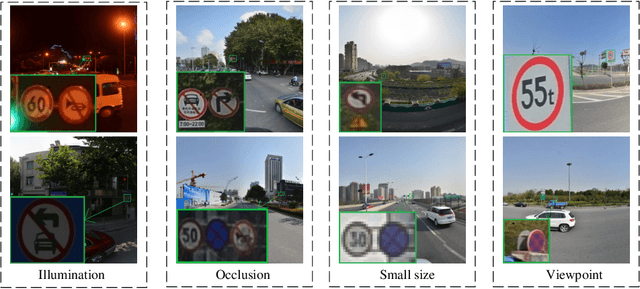
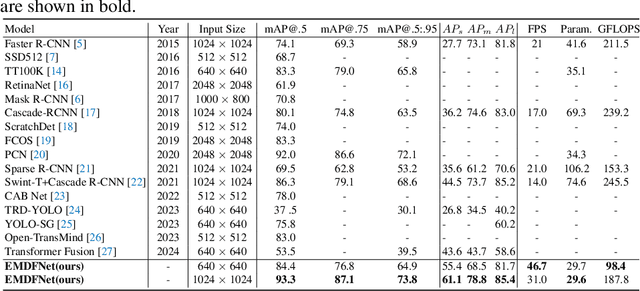
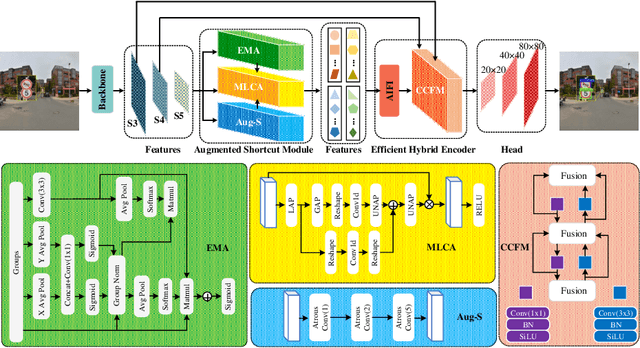
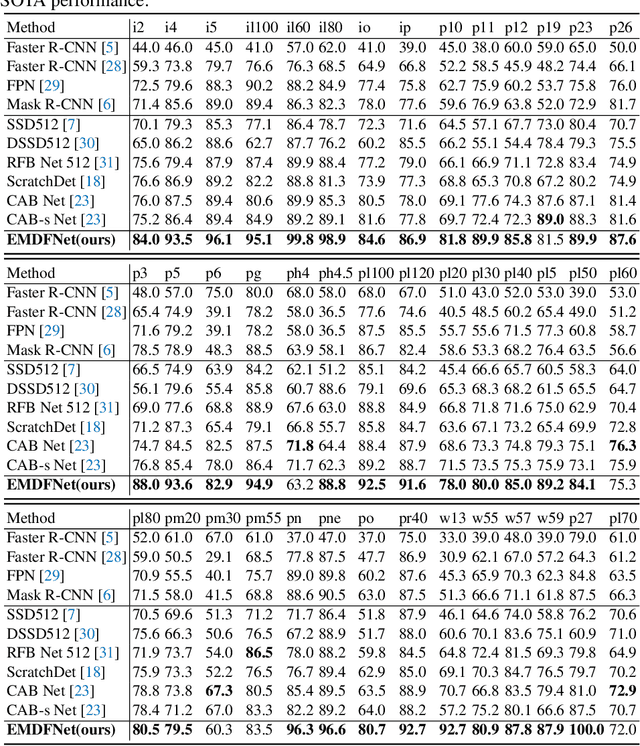
Abstract:The detection of small objects, particularly traffic signs, is a critical subtask within object detection and autonomous driving. Despite the notable achievements in previous research, two primary challenges persist. Firstly, the main issue is the singleness of feature extraction. Secondly, the detection process fails to effectively integrate with objects of varying sizes or scales. These issues are also prevalent in generic object detection. Motivated by these challenges, in this paper, we propose a novel object detection network named Efficient Multi-scale and Diverse Feature Network (EMDFNet) for traffic sign detection that integrates an Augmented Shortcut Module and an Efficient Hybrid Encoder to address the aforementioned issues simultaneously. Specifically, the Augmented Shortcut Module utilizes multiple branches to integrate various spatial semantic information and channel semantic information, thereby enhancing feature diversity. The Efficient Hybrid Encoder utilizes global feature fusion and local feature interaction based on various features to generate distinctive classification features by integrating feature information in an adaptable manner. Extensive experiments on the Tsinghua-Tencent 100K (TT100K) benchmark and the German Traffic Sign Detection Benchmark (GTSDB) demonstrate that our EMDFNet outperforms other state-of-the-art detectors in performance while retaining the real-time processing capabilities of single-stage models. This substantiates the effectiveness of EMDFNet in detecting small traffic signs.
PersonificationNet: Making customized subject act like a person
Jul 12, 2024



Abstract:Recently customized generation has significant potential, which uses as few as 3-5 user-provided images to train a model to synthesize new images of a specified subject. Though subsequent applications enhance the flexibility and diversity of customized generation, fine-grained control over the given subject acting like the person's pose is still lack of study. In this paper, we propose a PersonificationNet, which can control the specified subject such as a cartoon character or plush toy to act the same pose as a given referenced person's image. It contains a customized branch, a pose condition branch and a structure alignment module. Specifically, first, the customized branch mimics specified subject appearance. Second, the pose condition branch transfers the body structure information from the human to variant instances. Last, the structure alignment module bridges the structure gap between human and specified subject in the inference stage. Experimental results show our proposed PersonificationNet outperforms the state-of-the-art methods.
Sim2Real in Reconstructive Spectroscopy: Deep Learning with Augmented Device-Informed Data Simulation
Mar 19, 2024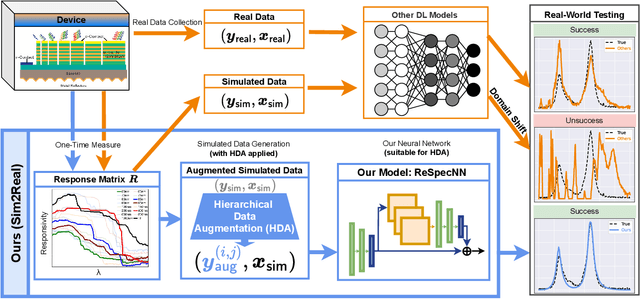



Abstract:This work proposes a deep learning (DL)-based framework, namely Sim2Real, for spectral signal reconstruction in reconstructive spectroscopy, focusing on efficient data sampling and fast inference time. The work focuses on the challenge of reconstructing real-world spectral signals under the extreme setting where only device-informed simulated data are available for training. Such device-informed simulated data are much easier to collect than real-world data but exhibit large distribution shifts from their real-world counterparts. To leverage such simulated data effectively, a hierarchical data augmentation strategy is introduced to mitigate the adverse effects of this domain shift, and a corresponding neural network for the spectral signal reconstruction with our augmented data is designed. Experiments using a real dataset measured from our spectrometer device demonstrate that Sim2Real achieves significant speed-up during the inference while attaining on-par performance with the state-of-the-art optimization-based methods.
Neural Collapse in Multi-label Learning with Pick-all-label Loss
Nov 01, 2023



Abstract:We study deep neural networks for the multi-label classification (MLab) task through the lens of neural collapse (NC). Previous works have been restricted to the multi-class classification setting and discovered a prevalent NC phenomenon comprising of the following properties for the last-layer features: (i) the variability of features within every class collapses to zero, (ii) the set of feature means form an equi-angular tight frame (ETF), and (iii) the last layer classifiers collapse to the feature mean upon some scaling. We generalize the study to multi-label learning, and prove for the first time that a generalized NC phenomenon holds with the "pick-all-label" formulation. Under the natural analog of the unconstrained feature model (UFM), we establish that the only global classifier of the pick-all-label cross entropy loss display the same ETF geometry which further collapse to multiplicity-1 feature class means. Besides, we discover a combinatorial property in generalized NC which is unique for multi-label learning that we call "tag-wise average" property, where the feature class-means of samples with multiple labels are scaled average of the feature class-means of single label tags. Theoretically, we establish global optimality result for the pick-all-label cross-entropy risk for the UFM. Additionally, We also provide empirical evidence to support our investigation into training deep neural networks on multi-label datasets, resulting in improved training efficiency.
FastInst: A Simple Query-Based Model for Real-Time Instance Segmentation
Apr 01, 2023



Abstract:Recent attention in instance segmentation has focused on query-based models. Despite being non-maximum suppression (NMS)-free and end-to-end, the superiority of these models on high-accuracy real-time benchmarks has not been well demonstrated. In this paper, we show the strong potential of query-based models on efficient instance segmentation algorithm designs. We present FastInst, a simple, effective query-based framework for real-time instance segmentation. FastInst can execute at a real-time speed (i.e., 32.5 FPS) while yielding an AP of more than 40 (i.e., 40.5 AP) on COCO test-dev without bells and whistles. Specifically, FastInst follows the meta-architecture of recently introduced Mask2Former. Its key designs include instance activation-guided queries, dual-path update strategy, and ground truth mask-guided learning, which enable us to use lighter pixel decoders, fewer Transformer decoder layers, while achieving better performance. The experiments show that FastInst outperforms most state-of-the-art real-time counterparts, including strong fully convolutional baselines, in both speed and accuracy. Code can be found at https://github.com/junjiehe96/FastInst .
Learning Polysemantic Spoof Trace: A Multi-Modal Disentanglement Network for Face Anti-spoofing
Dec 07, 2022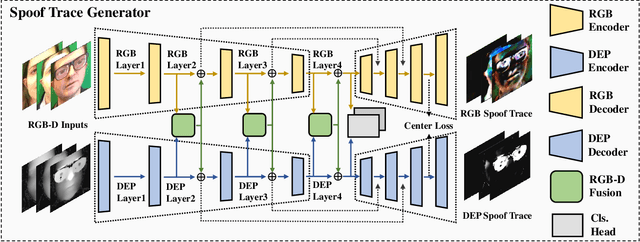
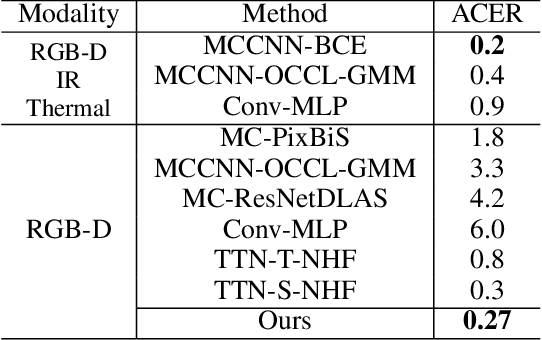
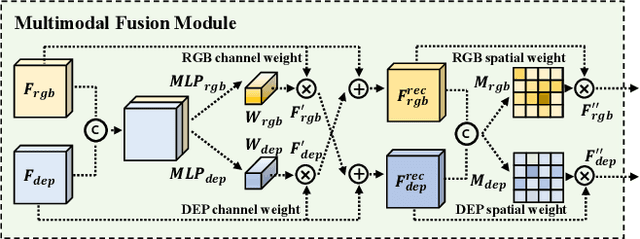

Abstract:Along with the widespread use of face recognition systems, their vulnerability has become highlighted. While existing face anti-spoofing methods can be generalized between attack types, generic solutions are still challenging due to the diversity of spoof characteristics. Recently, the spoof trace disentanglement framework has shown great potential for coping with both seen and unseen spoof scenarios, but the performance is largely restricted by the single-modal input. This paper focuses on this issue and presents a multi-modal disentanglement model which targetedly learns polysemantic spoof traces for more accurate and robust generic attack detection. In particular, based on the adversarial learning mechanism, a two-stream disentangling network is designed to estimate spoof patterns from the RGB and depth inputs, respectively. In this case, it captures complementary spoofing clues inhering in different attacks. Furthermore, a fusion module is exploited, which recalibrates both representations at multiple stages to promote the disentanglement in each individual modality. It then performs cross-modality aggregation to deliver a more comprehensive spoof trace representation for prediction. Extensive evaluations are conducted on multiple benchmarks, demonstrating that learning polysemantic spoof traces favorably contributes to anti-spoofing with more perceptible and interpretable results.
 Add to Chrome
Add to Chrome Add to Firefox
Add to Firefox Add to Edge
Add to Edge